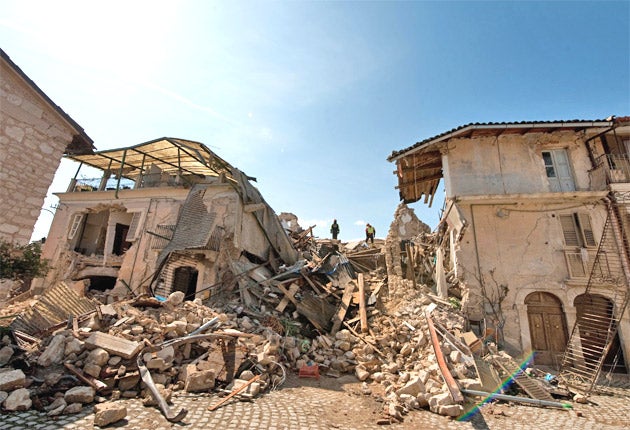Italian scientists jailed for six years after failing to issue warnings ahead of deadly L’Aquila earthquake
Leading geophysicists say trial over deadly L’Aquila quake should never have been held

Your support helps us to tell the story
From reproductive rights to climate change to Big Tech, The Independent is on the ground when the story is developing. Whether it's investigating the financials of Elon Musk's pro-Trump PAC or producing our latest documentary, 'The A Word', which shines a light on the American women fighting for reproductive rights, we know how important it is to parse out the facts from the messaging.
At such a critical moment in US history, we need reporters on the ground. Your donation allows us to keep sending journalists to speak to both sides of the story.
The Independent is trusted by Americans across the entire political spectrum. And unlike many other quality news outlets, we choose not to lock Americans out of our reporting and analysis with paywalls. We believe quality journalism should be available to everyone, paid for by those who can afford it.
Your support makes all the difference.An Italian court has handed down six-year jail sentences to six scientists and a senior government official for failing to properly communicate the risk ahead of the deadly L’Aquila earthquake, in a verdict that will shock and surprise the international scientific community.
In the regional court in L’Aquila, the medieval city levelled by the April 2009 disaster, all seven were found guilty of manslaughter. Two judges decided the experts had downplayed the risk of a massive quake striking the region in the days ahead of the tragedy.
In the event, 309 lives were lost in the early hours of 6 April as citizens’ ancient homes collapsed around them while they slept. The seven convicted, all members of a civil protection agency called the National Commission for the Forecast and Prevention of Major Risks, were accused by prosecutors of negligence and malpractice in their duty of protecting the public. All seven denied the charges.
The defendants include the prominent scientists Enzo Boschi, the former president of Italy’s National Institute of Geophysics and Volcanology; and Giulio Selvaggi, the organisation’s current head. They were members of a panel that met six days before the disaster to assess risk after a series of tremors shook the city.
After today’s verdict Dr Boschi said: “I am dejected, desperate. I thought I would have been acquitted. I still don’t understand what I was convicted of.”
The case has drawn wide condemnation from leading scientists around the world. Dr John Elliott of Oxford University’s Department of Earth Sciences said today: “This verdict is a sad end to a tragic series of events in L’Aquila. Earthquakes cannot be predicted, and these scientists should not even have been on trial accused of providing incomplete information.”
The American Geophysical Union has warned that the risk of future litigation may deter scientists from advising governments or even working to assess seismic risk.
But Wania della Vigna, a lawyer who represented 11 of the plaintiffs, said: “This is a historic sentence, above all for the victims.”
The experts were also ordered to pay more than €9m (£7.3m) in damages. Italian courts have a reputation for being unafraid to challenge mainstream scientific opinion.
But the case against the seven experts in L’Aquila was more subtle than it at first appeared. The prosecution – and many survivors – did not contend that the experts ought to have predicted when the quake would strike.
Instead they accused them of downplaying the risk that it might occur following a series of small tremors in the area. As a result it was claimed that many inhabitants who would have fled their ancient homes instead remained indoors on the night of 5 April, 2009, when L’Aquila was razed.
Notoriously, one of the seven convicted, Bernardo De Bernardinis, a senior figure in Italy’s Civil Protection Agency, appeared to respond casually to question about the risk at a press conference on 31 March, saying there was “no danger” because the small shocks indicated that a “continuous discharge of energy” was occurring.
That advice was considered to be untrue. And many senior scientists have said the panel should have warned the public that the occurrence of 400 or so small shocks in the region in the days ahead of the disaster raised the chances of an imminent major earthquake.
Join our commenting forum
Join thought-provoking conversations, follow other Independent readers and see their replies
Comments